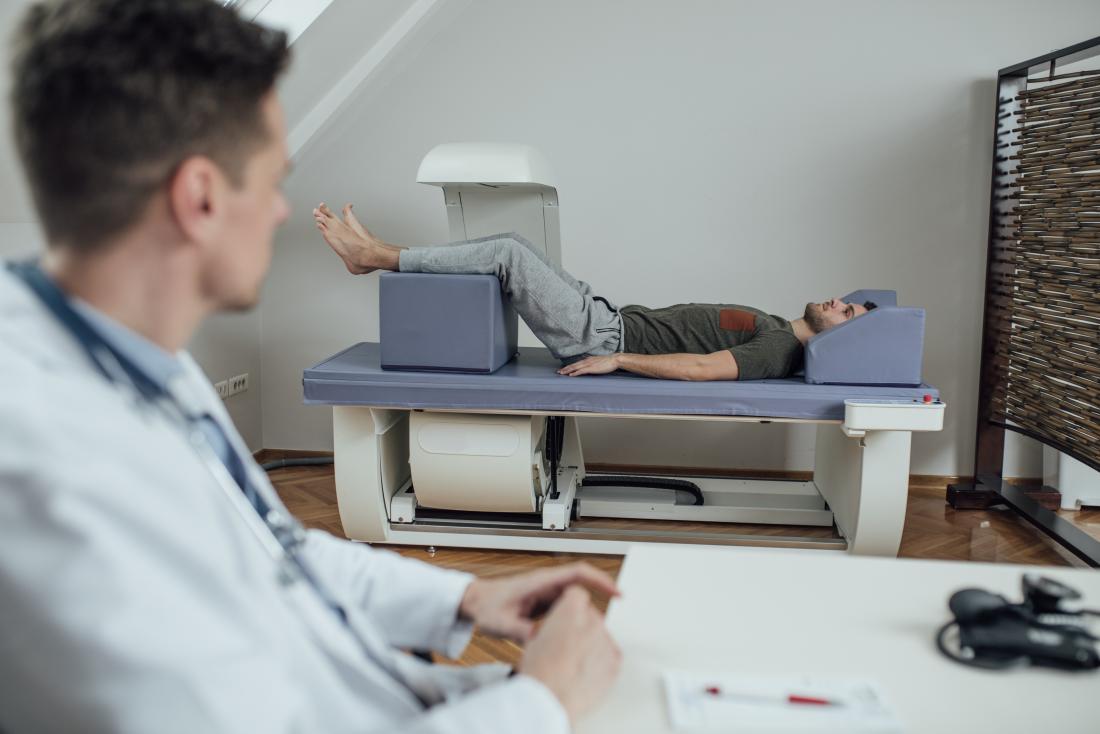The dual-energy X-ray absorptiometry (DEXA) scan uses two low-energy X-ray beams, which doctors direct toward the bones. Using dual energy levels separates the images into two components, including soft tissue and bone.
When determining whether a person has low bone density or whether the condition is getting worse, a DEXA scan tends to be more accurate than a typical X-ray because it can detect even small changes in bone loss.
Doctors also consider it more reliable than other methods of calculating body fat percentage, including underwater weighing.
Scan results may indicate the severity of bone loss and help doctors determine a person’s risk of developing a fracture.
When assessing body composition, the results may also help determine a person’s level of visceral fat, which the body stores around certain internal organs.
Purpose

Doctors may use a DEXA scan to diagnose osteoporosis.
The most common purpose of a DEXA scan is to assess whether a person’s bones are weak and or at risk of fracture. It also helps a doctor diagnose osteoporosis.
Osteoporosis causes the bones to lose density or become thin. When the bones get thin, they also become fragile, which makes them more susceptible to breaks.
Determining whether a person has osteoporosis as early as possible is important to prevent the condition from becoming worse. It also reduces the risk of fractures.
A DEXA scan is also a useful diagnostic tool to assess whether or not osteoporosis is getting worse. After the first DEXA scan, a doctor will usually order another scan in a couple of years to determine whether the bone density has changed.
DEXA scans can also evaluate the effectiveness of any prescribed osteoporosis treatments. The scan may indicate worsening or improving bone density, or bone density that remains the same.
According to the National Osteoporosis Foundation, females over the age of 65 and males over age 70 should have a DEXA scan. The ideal frequency of scans may vary depending on the results.
People receiving treatment for osteoporosis may require a scan every 1 or 2 years.
Females who are postmenopausal but younger than 65 who also have risk factors for low bone density, such as steroid medication use or low body weight, should also have the scan.
The recommendation for females to undergo a DEXA scan at an earlier age than males is because they tend to develop loss of bone density sooner.
Procedure
A person does not need to prepare before they have a DEXA scan. They can eat and drink normally on the day of the procedure.
However, people who are taking calcium supplements will usually need to stop taking them around 24 hours before the scan.
Before the scan
An X-ray technician will perform the scan on an outpatient basis. People who are having the scan will change into a hospital gown and remove any metal objects they are wearing, such as jewelry and eyeglasses.
At the start of the scan, the person receiving the test lies on their back on the exam table. The technician will place an imaging device above them and an X-ray generator below them.
During the scan
During the procedure, the imaging arm moves slowly over the person’s body while a beam of low-dose energy passes through. When measuring bone density, the technician will usually scan the hips and spine. These are common locations of fractures in people with osteoporosis.
In some cases, the wrist, finger, and lower arm will undergo scanning. A procedure that doctors call a vertebral fracture assessment may also occur during a DEXA scan at some locations. This test determines whether a vertebral fracture risk is present.
When also measuring body composition, the entire body undergoes scanning. This measures skinfold thickness at specific sites on the body. Using an equation, it is possible to put the measurements together to determine a body fat percentage.
Safety and precautions
During the scan, people should remain still to prevent blurry images. The scan is painless and relatively quick, taking up to 30 minutes.
The DEXA scan is safe for most people. However, because it uses X-ray energy, there is exposure to radiation. People who are pregnant should talk with their doctor, who may advise them not to have the test.
Results

A doctor can determine the most suitable treatment option by using the results of a DEXA scan.
The results of a DEXA scan for bone density use a system called a T-score. The T-score involves comparing a person’s scan with the bone density of a healthy young adult of the same sex.
The World Health Organization (WHO) provide the following definitions of bone density levels:
- A T-score of -1.0 or higher is normal bone density.
- A T-score of -1.1 to -2.4 indicates osteopenia, or low bone density.
- A T-score of -2.5 or lower means a diagnosis of osteoporosis.
A DEXA scan may also report results using a Z-score, which reports the amount of bone a person has in comparison with other people of the same size, age, and sex. It can help determine whether something uncommon is leading to bone loss.
According to the International Society for Clinical Densitometry, a Z-score that is over -2.0 is considered normal. A score that is below -2.0 is what doctors interpret as below the normal range for the person’s age.
When the test also measures body composition, results include a total fat mass and total body fat percentage.
Takeaway
The DEXA scan is a useful diagnostic test that doctors use to determine whether a person has low bone density and or a higher risk of experiencing fractures.
The test may also provide information on body fat percentage.
The results of the scan can help a doctor determine whether treatment is necessary for osteoporosis and help monitor the effectiveness of treatment.
Although the scan exposes the person to a small amount of radiation, the benefits are usually worth the risk.
